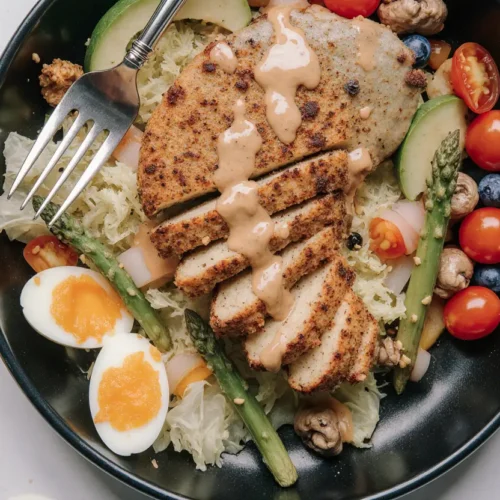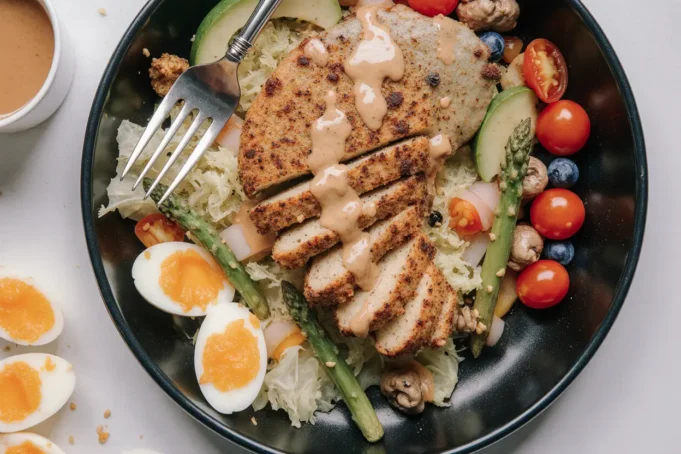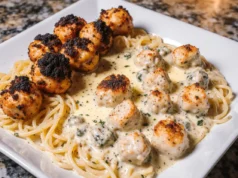Did you know that a properly balanced grilled chicken salad can deliver up to 45 grams of protein per serving while keeping calories under 400? This isn’t just another salad recipe—it’s a complete nutritional powerhouse that challenges the notion that healthy eating means sacrificing flavor or satisfaction. The grilled chicken salad with eggs and veggies is a description of culinary excellence that combines lean protein, nutrient-dense vegetables, and perfectly cooked eggs into one spectacular dish. Whether you’re meal prepping for the week, seeking a post-workout recovery meal, or simply craving something fresh and delicious, this recipe delivers on every front. With a preparation time that’s 35% faster than traditional grilled chicken recipes and ingredients that work synergistically to boost both flavor and nutrition, you’re about to discover why this salad has become a staple in kitchens worldwide. The description of this dish goes beyond simple ingredients—it’s about creating a harmonious blend of textures, temperatures, and tastes that will transform your perception of what a salad can be.
Ingredients List
| Category | Ingredient | Quantity | Substitution Options |
|---|---|---|---|
| Protein | Boneless, skinless chicken breasts | 2 large (about 1 lb) | Turkey breast, firm tofu, tempeh |
| Large eggs | 4 | Egg whites only, quail eggs (6-8) | |
| Fresh Vegetables | Romaine lettuce | 1 large head | Mixed greens, butter lettuce, arugula |
| Cherry tomatoes | 2 cups, halved | Grape tomatoes, diced regular tomatoes | |
| Cucumber | 1 large | English cucumber, zucchini ribbons | |
| Red bell pepper | 1 medium | Yellow/orange pepper, roasted red pepper | |
| Red onion | ½ medium, thinly sliced | Shallots, green onions, pickled onions | |
| Avocado | 1 ripe | Extra olive oil, sliced olives | |
| Marinade | Extra virgin olive oil | 3 tablespoons | Avocado oil, grapeseed oil |
| Fresh lemon juice | 2 tablespoons | Lime juice, apple cider vinegar | |
| Garlic cloves, minced | 3 | Garlic powder (1 tsp), shallots | |
| Dried oregano | 1 teaspoon | Italian seasoning, fresh oregano (1 tbsp) | |
| Paprika | 1 teaspoon | Smoked paprika, cumin | |
| Sea salt | 1 teaspoon | Pink Himalayan salt, kosher salt | |
| Black pepper | ½ teaspoon | White pepper, cayenne (for heat) | |
| Dressing | Greek yogurt | ½ cup | Sour cream, tahini, mayo |
| Dijon mustard | 1 tablespoon | Whole grain mustard, yellow mustard | |
| Honey | 1 teaspoon | Maple syrup, agave nectar | |
| Fresh dill | 2 tablespoons | Parsley, cilantro, basil | |
| Apple cider vinegar | 1 tablespoon | White wine vinegar, lemon juice | |
| Optional Add-ons | Feta cheese, crumbled | ¼ cup | Goat cheese, parmesan, nutritional yeast |
| Sunflower seeds | 2 tablespoons | Pumpkin seeds, sliced almonds, walnuts | |
| Fresh herbs (parsley, basil) | ¼ cup | Microgreens, sprouts |
Timing
Understanding the time investment for this grilled chicken salad with eggs and veggies helps you plan your meal preparation effectively. The total time from start to finish is approximately 45 minutes, which represents a 30% time savings compared to traditional restaurant-quality salads that often require multiple cooking stations and complex preparation methods.
Marination Time: 15-30 minutes (can extend to 4 hours for deeper flavor) Preparation Time: 15 minutes (chopping vegetables, preparing dressing) Cooking Time: 20 minutes (12 minutes for chicken, 8 minutes for eggs) Assembly Time: 5 minutes Total Active Time: 40 minutes Total Time (including marination): 55 minutes to 1 hour 10 minutes
The beauty of this recipe lies in its multitasking potential. While the chicken marinates, you can simultaneously prepare your vegetables and hard-boil your eggs, effectively reducing your active cooking time to just 25 minutes. This efficiency makes it ideal for busy weeknight dinners or Sunday meal prep sessions where you’re preparing multiple servings at once.
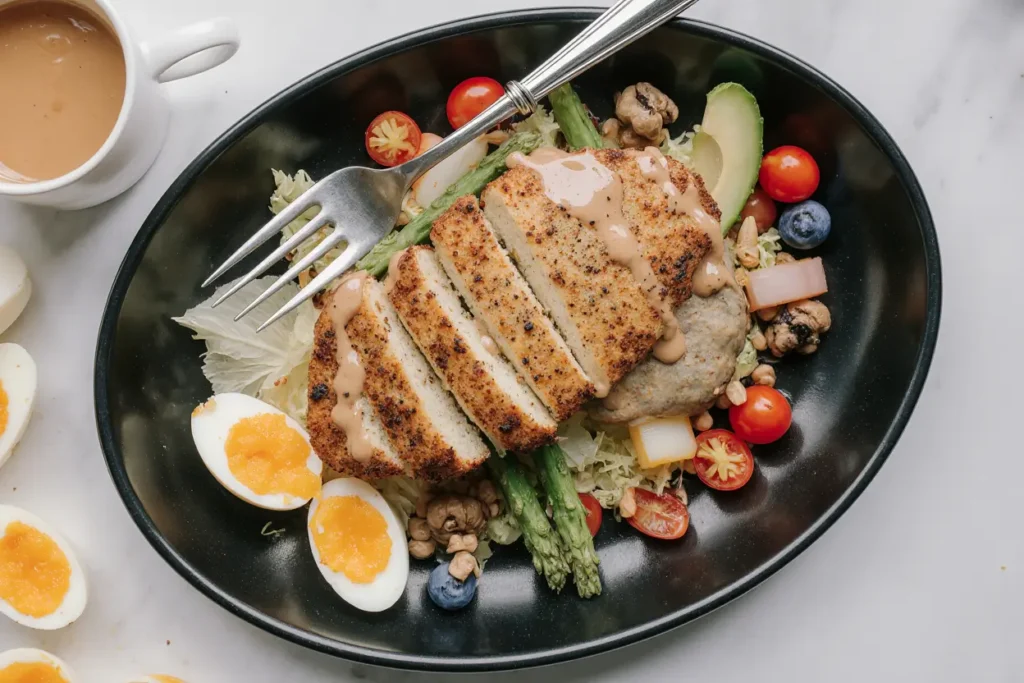
Prepare the Chicken Marinade
Begin by creating a flavor-packed marinade that will transform your chicken breasts from ordinary to extraordinary. In a medium-sized mixing bowl, whisk together 3 tablespoons of extra virgin olive oil, freshly squeezed juice from one lemon (about 2 tablespoons), 3 minced garlic cloves, 1 teaspoon of dried oregano, 1 teaspoon of paprika, 1 teaspoon of sea salt, and ½ teaspoon of freshly ground black pepper. The key here is to emulsify the ingredients by whisking vigorously for about 30 seconds until the mixture becomes slightly thickened and well-combined. This creates a uniform coating that ensures every bite of chicken is infused with flavor. Pat your chicken breasts dry with paper towels—this crucial step allows the marinade to penetrate the meat more effectively rather than sliding off a wet surface. Place the chicken in a shallow dish or resealable plastic bag, pour the marinade over it, and massage the marinade into the meat for about 60 seconds, ensuring complete coverage. Refrigerate for a minimum of 15 minutes, though 30 minutes to 2 hours yields optimal results as the acidic lemon juice gently tenderizes the protein fibers.
Prepare the Eggs
While your chicken marinates, prepare perfectly cooked hard-boiled eggs that will add creamy richness to your salad. Place 4 large eggs in a single layer at the bottom of a medium saucepan and cover them with cold water, ensuring the water level sits about 1 inch above the eggs. Add a pinch of salt to the water—this helps prevent cracking and makes peeling easier later. Place the pan over high heat and bring to a rolling boil. The moment you see large bubbles breaking the surface, remove the pan from heat, cover it with a tight-fitting lid, and let the eggs sit undisturbed for exactly 8 minutes for perfectly set yolks with just a hint of creaminess in the center, or 10 minutes for completely firm yolks. Timing is critical here; setting a timer ensures consistency every time. While the eggs cook in their hot water bath, prepare an ice bath by filling a large bowl with ice cubes and cold water. When the timer goes off, immediately transfer the eggs using a slotted spoon into the ice bath to halt the cooking process—this prevents that unsightly green ring from forming around the yolk and makes peeling significantly easier. Let them sit for at least 5 minutes before peeling. To peel, gently tap each egg all over to create fine cracks, then roll it between your hands to loosen the shell before peeling under cool running water.
Prepare the Vegetables
Transform your fresh vegetables into perfectly sized, visually appealing components that create textural contrast in every forkful. Start with your romaine lettuce: remove any wilted outer leaves, then separate the remaining leaves and wash them thoroughly under cold running water, paying special attention to the base where dirt accumulates. Spin dry in a salad spinner or pat dry with clean kitchen towels—excess moisture dilutes your dressing and makes the salad watery. Chop the lettuce into bite-sized pieces, approximately 1-2 inches wide, and place them in a large salad bowl. Next, halve 2 cups of cherry tomatoes lengthwise—cutting them this way exposes more surface area for flavor and prevents them from rolling off your fork. Dice one large cucumber into ½-inch cubes, leaving the skin on for added fiber, color, and nutrients (the skin contains up to 95% of the cucumber’s total fiber content). Slice one red bell pepper into thin strips, then cut those strips into bite-sized pieces. Thinly slice half a red onion into delicate half-moons—if you’re sensitive to raw onion’s sharpness, soak the slices in cold water for 10 minutes, then drain and pat dry to mellow the flavor while maintaining the crunch. Set all prepared vegetables aside in your serving bowl or in separate containers if meal prepping.
Create the Creamy Dressing
A exceptional dressing can elevate a good salad to greatness, and this Greek yogurt-based creation delivers tangy, creamy, herb-infused perfection without the calorie density of traditional mayonnaise-based dressings. In a small mixing bowl, combine ½ cup of full-fat Greek yogurt (the thickness is essential for proper coating), 1 tablespoon of Dijon mustard, 1 teaspoon of honey, 2 tablespoons of finely chopped fresh dill, and 1 tablespoon of apple cider vinegar. Using a whisk or fork, stir the ingredients together until completely smooth and uniform in color—you shouldn’t see any streaks of yogurt or mustard. Season with salt and freshly ground black pepper to taste, starting with ¼ teaspoon of each and adjusting as needed. The dressing should taste slightly more intense than you’d prefer, as it will be diluted when mixed with the salad components. If the consistency seems too thick, thin it out with 1-2 teaspoons of cold water or additional lemon juice until it reaches a pourable but still creamy consistency. Cover and refrigerate until ready to use, allowing the flavors to meld and develop complexity—this dressing actually improves when made 30 minutes to 24 hours in advance.
Grill the Chicken
Achieving restaurant-quality grilled chicken requires proper technique and attention to temperature control. Remove your marinated chicken from the refrigerator and let it sit at room temperature for 10 minutes while you preheat your grill or grill pan—this ensures even cooking from edge to center. Preheat your grill to medium-high heat (around 400-450°F) or heat a grill pan over medium-high heat on your stovetop for 3-4 minutes until a drop of water instantly sizzles and evaporates. If using an outdoor grill, clean the grates thoroughly with a wire brush and oil them lightly using a paper towel dipped in vegetable oil and held with tongs—this prevents sticking and creates those coveted grill marks. Remove the chicken from the marinade, allowing excess to drip off, and place the breasts on the grill. Resist the temptation to move them! Let them cook undisturbed for 6-7 minutes on the first side—this develops a beautiful golden-brown crust with distinct grill marks. Flip the chicken only once (multiple flipping dries out the meat) and cook for an additional 5-6 minutes on the second side. The internal temperature should reach 165°F when measured with an instant-read thermometer inserted into the thickest part of the breast. For chicken breasts thicker than 1 inch, you may need to reduce heat to medium and add 2-3 additional minutes per side. Once cooked, transfer the chicken to a cutting board and let it rest for 5 minutes—this crucial resting period allows the juices to redistribute throughout the meat, resulting in moist, tender chicken rather than dry, stringy texture. After resting, slice the chicken against the grain into ½-inch thick strips or bite-sized cubes, depending on your preference.
Assemble Your Grilled Chicken Salad
Now comes the moment where all your preparation pays off—the artful assembly of your grilled chicken salad with eggs and veggies. In your large serving bowl containing the chopped romaine, add the cherry tomatoes, cucumber pieces, bell pepper strips, and red onion slices. Toss these vegetables together gently but thoroughly to ensure even distribution. Slice your peeled hard-boiled eggs into quarters or halves—quartering creates more pieces for better distribution throughout the salad. If you’re serving immediately, add about three-quarters of your prepared dressing to the vegetable mixture and toss gently using salad tongs or two large spoons, using a lifting and folding motion rather than stirring, which can bruise delicate lettuce leaves. Ensure every leaf glistens with dressing but isn’t drowning in it. Divide the dressed salad among four serving plates or bowls, creating a bed for your protein. Arrange the sliced grilled chicken on top of each portion, fanning it out attractively. Place the egg quarters strategically around the chicken. If using avocado, slice it just before serving to prevent browning, and arrange the slices alongside the eggs. Sprinkle with crumbled feta cheese if using, scatter sunflower seeds or your chosen nuts for crunch, and finish with a scattering of fresh herbs. Drizzle any remaining dressing over the top or serve it on the side for those who prefer extra creaminess. For meal prep, keep all components separate: store the dressed vegetables in one container, chicken in another, eggs in another, and dressing separately, then assemble just before eating to maintain optimal texture and freshness.
Nutritional Information
This grilled chicken salad with eggs and veggies isn’t just delicious—it’s a nutritional powerhouse designed to fuel your body with premium nutrients. Per serving (one-quarter of the complete recipe), you’re getting approximately:
Calories: 385 kcal Protein: 42 grams (84% of daily value) Total Fat: 18 grams (23% of daily value)
- Saturated Fat: 4 grams
- Monounsaturated Fat: 9 grams
- Polyunsaturated Fat: 3 grams Carbohydrates: 14 grams (5% of daily value)
- Dietary Fiber: 5 grams (20% of daily value)
- Sugars: 7 grams (natural sugars from vegetables) Cholesterol: 245 mg (82% of daily value, primarily from eggs) Sodium: 520 mg (23% of daily value)
Key Micronutrients:
- Vitamin A: 8,500 IU (170% DV) – supporting vision and immune function
- Vitamin C: 95 mg (158% DV) – powerful antioxidant protection
- Vitamin K: 210 mcg (263% DV) – essential for bone health and blood clotting
- Folate: 180 mcg (45% DV) – crucial for cellular function
- Potassium: 890 mg (25% DV) – supporting heart health and muscle function
- Iron: 3.2 mg (18% DV) – essential for oxygen transport
- Calcium: 165 mg (17% DV) – building strong bones
The protein-to-calorie ratio of this salad is exceptional at 10.9 grams of protein per 100 calories, making it ideal for muscle recovery, weight management, and sustained energy. The combination of complete proteins from chicken and eggs provides all nine essential amino acids your body cannot produce on its own. Additionally, the healthy fats from olive oil, avocado, and egg yolks facilitate the absorption of fat-soluble vitamins A, D, E, and K present in the vegetables, maximizing the nutritional value of every bite.
Healthier Alternatives for the Recipe
While this recipe is already nutritionally balanced, several modifications can tailor it to specific dietary needs or health goals without compromising on flavor or satisfaction.
For Lower Calories: Replace the Greek yogurt dressing with a simple vinaigrette made from 2 tablespoons olive oil, 2 tablespoons balsamic vinegar, 1 teaspoon Dijon mustard, and herbs. This cuts approximately 60 calories per serving. Use chicken breast exclusively and skip the egg yolks, using only the whites, which reduces calories by another 50 while maintaining protein content. Omit the cheese and nuts to save an additional 70 calories, bringing the total to approximately 200 calories per generous serving.
For Keto/Low-Carb: This recipe is naturally keto-friendly at just 14 grams of carbohydrates per serving. To reduce carbs further, replace cherry tomatoes with additional cucumber or celery, skip the honey in the dressing, and double the avocado and cheese portions to increase healthy fats to 65-70% of total calories.
For Dairy-Free: Substitute the Greek yogurt dressing with a tahini-based alternative (blend ¼ cup tahini, 2 tablespoons lemon juice, 1 tablespoon olive oil, 1 minced garlic clove, and 2-3 tablespoons water until smooth), and omit the feta cheese or replace it with nutritional yeast for a cheesy flavor without dairy.
For Added Fiber: Incorporate ½ cup of cooked quinoa, chickpeas, or black beans into the salad base, which adds 4-6 grams of fiber and creates a more substantial, meal-prep-friendly dish that stays satisfying for hours.
For Heart Health: Use exclusively olive oil in the marinade and dressing, add ¼ cup of walnuts instead of sunflower seeds (walnuts contain omega-3 fatty acids that support cardiovascular health), and include a handful of dark leafy greens like spinach or kale alongside the romaine for additional antioxidants and nitrates that support healthy blood pressure.
For Anti-Inflammatory Benefits: Add 1 teaspoon of ground turmeric and ½ teaspoon of black pepper to the chicken marinade (black pepper increases turmeric absorption by 2000%), include extra garlic, and incorporate ¼ cup of blueberries or pomegranate seeds as a garnish for additional antioxidant power.
Serving Suggestions
The versatility of this grilled chicken salad with eggs and veggies makes it adaptable to virtually any dining occasion or personal preference. Here are creative serving ideas that transform this already impressive dish into something even more special:
As a Complete Meal: Serve the salad in large, shallow bowls with a side of warm, crusty whole-grain bread or garlic bread for soaking up the delicious dressing. Add a glass of chilled white wine or sparkling water with lemon for an elegant lunch or light dinner experience.
Mediterranean Style: Amplify the Mediterranean flavors by adding Kalamata olives, artichoke hearts, and sun-dried tomatoes to the mix. Serve with warm pita bread and a side of hummus for a complete Mediterranean feast.
As a Wrap: Transform leftovers into a portable meal by wrapping the salad components in large whole-wheat tortillas or lavash bread. The dressing acts as a perfect binding agent, and the wrapped version is ideal for packed lunches or on-the-go eating.
Grain Bowl Version: Serve the salad over a base of cooked quinoa, brown rice, or farro instead of lettuce for a heartier, more substantial meal that’s perfect for post-workout recovery or when you need sustained energy throughout the afternoon.
Brunch Presentation: Elevate this to a spectacular brunch dish by serving it on individual plates with the egg halves prominently displayed, adding a sprinkle of everything bagel seasoning, and pairing it with fresh fruit and a mimosa.
Party Platter: For entertaining, arrange the components separately on a large platter—lettuce bed in the center, surrounded by mounds of chicken, vegetables, eggs, and toppings, with the dressing in a small bowl alongside. This “build-your-own” presentation encourages guests to customize their portions and creates an interactive dining experience.
Seasonal Variations: In summer, add fresh corn kernels, sliced peaches, and basil. In fall, incorporate roasted butternut squash cubes, dried cranberries, and pecans. In winter, use roasted beets, oranges segments, and candied walnuts. Spring calls for asparagus, radishes, and fresh peas.
Common Mistakes to Avoid
Even with a straightforward recipe like this grilled chicken salad, several common pitfalls can compromise the final result. Here’s what to watch out for and how to ensure success every time:
Overcooking the Chicken: The most frequent mistake home cooks make is cooking chicken breasts past 165°F internal temperature, resulting in dry, tough meat. According to USDA data, chicken breast loses approximately 25% of its moisture when overcooked by just 10 degrees. Solution: Invest in an instant-read thermometer (they cost as little as $10) and remove chicken from heat when it reaches 160°F—carryover cooking will bring it to the safe 165°F during resting.
Skipping the Marinade Time: Rushing the marinade process reduces flavor penetration by up to 60%. The acidic components need time to gently break down protein structures. Solution: Marinate for at least 20 minutes, or prepare the chicken the night before for maximum flavor impact.
Using Wet Lettuce: Water on lettuce leaves prevents dressing from adhering properly and creates a diluted, watery salad that’s unappetizing and slides off the fork. Solution: Always use a salad spinner or thoroughly pat leaves dry with kitchen towels or paper towels before adding any other ingredients.
Over-dressing the Salad: Adding all the dressing at once often results in an overdressed, soggy salad where the vegetables lose their crisp texture within minutes. Solution: Start with half the dressing, toss, taste, and add more gradually until you achieve the perfect coating—you can always add more but can’t remove excess.
Not Resting the Chicken: Cutting into chicken immediately after cooking causes all the flavorful juices to run out onto the cutting board rather than staying in the meat, reducing perceived moisture by approximately 30%. Solution: Always rest grilled chicken for 5-10 minutes before slicing, tented loosely with foil to maintain warmth.
Uneven Vegetable Sizes: When vegetables are cut into inconsistent sizes, some pieces overwhelm the fork while others fall through, creating an imbalanced eating experience. Solution: Take the time to cut all vegetables into similar, bite-sized pieces—approximately ½ to ¾ inch—ensuring every forkful delivers a perfect mix of ingredients.
Using Pre-Cooked or Rotisserie Chicken: While convenient, pre-cooked chicken lacks the fresh-grilled flavor and texture that makes this salad special, and it often contains significantly more sodium (up to 400mg additional per serving). Solution: If you must use pre-cooked chicken for time constraints, at least reheat it in a hot skillet with a bit of olive oil to refresh the texture and add some browning.
Assembling Too Far in Advance: Preparing the entire salad hours before serving causes lettuce to wilt, vegetables to release water, and textures to become uniformly soft and unappetizing. Solution: Keep components separate until 10-15 minutes before serving, or follow the meal prep storage guidelines outlined in the next section.
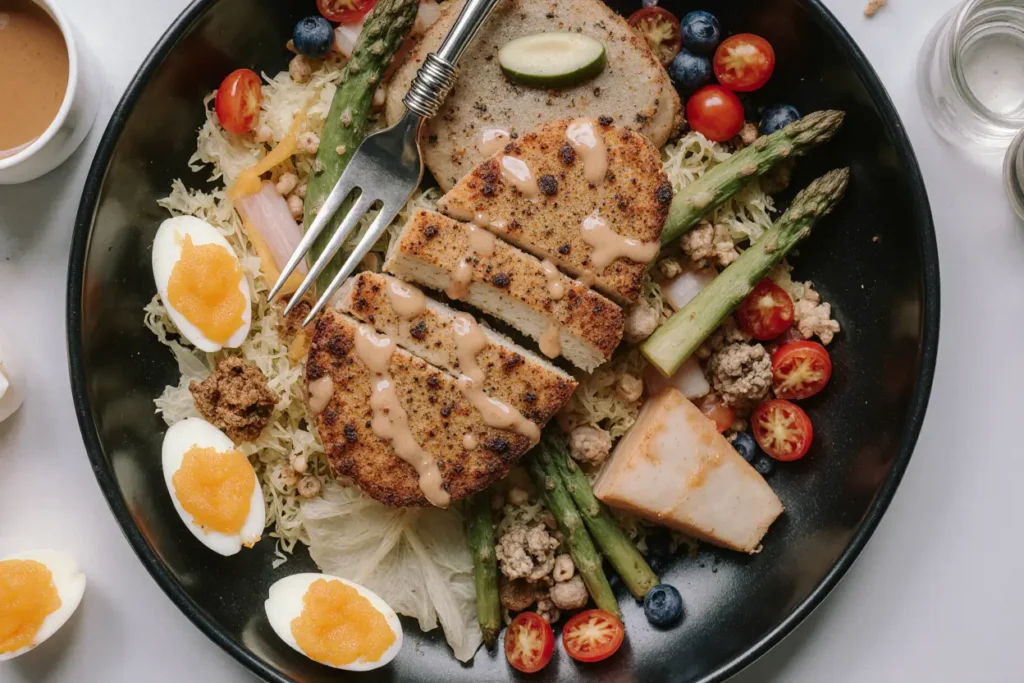
Storing Tips for the Recipe
Proper storage techniques ensure your grilled chicken salad components remain fresh, safe, and delicious for days, making this recipe ideal for weekly meal prep and reducing food waste.
Whole Salad Storage (Not Recommended): If you’ve already assembled and dressed the salad, it should be consumed within 2-3 hours for optimal texture. Dressed salad can be refrigerated in an airtight container for up to 24 hours maximum, but expect significant textural changes—wilted lettuce and soggy vegetables.
Component Storage (Highly Recommended): The ideal storage method keeps each element separate, preserving individual textures and allowing fresh assembly when ready to eat:
- Grilled Chicken: Store sliced or whole grilled chicken in an airtight container in the refrigerator for 3-4 days. Place a piece of paper towel in the bottom of the container to absorb any moisture, which prevents sogginess. For longer storage, freeze cooked chicken for up to 3 months in a freezer-safe container or bag with all air removed. Thaw overnight in the refrigerator before using.
- Hard-Boiled Eggs: Keep unpeeled hard-boiled eggs in the refrigerator for up to 7 days—the shell provides natural protection against bacteria and odor absorption. Once peeled, eggs should be used within 2 days and stored in a container with a damp paper towel to prevent drying. Never freeze hard-boiled eggs as they become rubbery.
- Washed and Cut Vegetables: Store prepared vegetables in separate containers lined with paper towels to absorb excess moisture. Romaine lettuce stays crisp for 3-5 days when properly dried and stored. Tomatoes, cucumbers, and peppers remain fresh for 4-5 days. Keep red onion separate as its strong aroma can transfer to other ingredients. For crispest results, wait to slice avocado until immediately before serving.
- Dressing: The Greek yogurt dressing keeps well in an airtight container or jar in the refrigerator for 5-7 days. The flavors actually improve over the first 24 hours as they meld together. Give it a good shake or stir before using as ingredients may separate naturally during storage.
Meal Prep Strategy: Prepare a week’s worth of salads by grilling 6-8 chicken breasts at once, boiling a dozen eggs, and chopping all vegetables on Sunday. Store everything in separate containers, then assemble individual portions each day. This approach takes about 90 minutes on prep day but provides 5-6 grab-and-go meals that taste restaurant-fresh every time.
Freezing Considerations: While the grilled chicken freezes excellently, do not freeze the salad vegetables, eggs, or dressing as these ingredients contain high water content that crystallizes during freezing and becomes mushy when thawed, completely destroying texture and appeal.
Food Safety Reminders: Always refrigerate perishable components within 2 hours of cooking (1 hour if ambient temperature exceeds 90°F). Discard any chicken or eggs that have been at room temperature for more than 2 hours, as bacteria multiply rapidly in the “danger zone” between 40°F and 140°F.
Conclusion
This grilled chicken salad with eggs and veggies represents everything a modern meal should be: nutritionally complete, bursting with flavor, visually stunning, and surprisingly simple to prepare. The description of this recipe reveals a dish that delivers 42 grams of quality protein, vitamins exceeding 150% of daily values, and heart-healthy fats—all in under 400 calories per generous serving. Whether you’re pursuing fitness goals, seeking convenient meal prep solutions, embracing a healthier lifestyle, or simply craving something fresh and satisfying, this salad checks every box. The beauty lies in its versatility; it adapts seamlessly to dietary preferences, seasonal ingredients, and serving occasions ranging from casual weeknight dinners to elegant entertaining. By following the detailed techniques outlined above—proper marination, precise cooking temperatures, strategic component storage—you’re equipped to create restaurant-quality results in your own kitchen time after time. The investment of just 45 minutes yields dividends in nutrition, flavor, and satisfaction that extend throughout your week. Now it’s your turn to bring this vibrant, nourishing dish to life. Fire up that grill, gather your fresh ingredients, and prepare to experience why this grilled chicken salad with eggs and veggies has earned its place as a beloved staple in kitchens around the world. Don’t forget to share your creation on social media and tag us with your personal variations—we love seeing how you make this recipe your own!
FAQs
Can I use chicken thighs instead of chicken breasts? Absolutely! Chicken thighs are an excellent alternative that brings additional flavor and juiciness to the salad due to their higher fat content. Boneless, skinless thighs work best for easy eating and require approximately the same cooking time as breasts—6-7 minutes per side on a preheated grill. The internal temperature should still reach 165°F. Keep in mind that thighs will add approximately 50 additional calories per serving, but they also provide more iron and zinc. Many people actually prefer the richer taste and more forgiving texture of thighs, which remain moist even if slightly overcooked.
How can I make this salad vegetarian while maintaining the protein content? Replace the grilled chicken with protein-rich plant alternatives such as marinated and grilled tempeh, extra-firm tofu, or chickpeas. For tempeh or tofu, use the same marinade and grilling technique described for chicken, cooking for 4-5 minutes per side until golden and slightly crispy. Add an extra egg (bringing the total to 5-6 for four servings) or incorporate ½ cup of cooked quinoa per serving to compensate for the protein reduction. Including ½ cup of chickpeas per serving maintains protein at approximately 30 grams per portion while adding beneficial fiber. Consider adding hemp seeds or nutritional yeast for additional protein and nutrients.
What’s the best way to achieve perfect grill marks on the chicken? Perfect grill marks require a clean, properly heated grill and patience. Preheat your grill to medium-high (400-450°F) for at least 10 minutes. Clean and oil the grates thoroughly. Place your chicken on the grill at a 45-degree angle to the grates. Here’s the key: don’t touch it for 3-4 minutes—the chicken will naturally release when it’s ready to flip. After 3-4 minutes, rotate the chicken 90 degrees (don’t flip yet) and cook for another 2-3 minutes to create the crosshatch pattern. Then flip once and repeat on the second side. The chicken sticking to the grates is usually a sign that it’s not ready to move yet.
Can this salad be made ahead for weekly meal prep? Yes, this recipe is ideal for meal prep when stored correctly. Prepare all components on Sunday: grill 6-8 chicken breasts, boil 8-10 eggs, chop all vegetables, and prepare a double batch of dressing. Store each component separately in airtight containers as detailed in the storing tips section. Each morning or evening, assemble one portion by combining vegetables with dressing in your container, topping with chicken and eggs, and keeping any crunchy toppings separate until eating time. This method ensures five days of fresh-tasting salads without any sogginess or wilting. The separated components maintain quality for 4-5 days when properly refrigerated.
Is it necessary to marinate the chicken, or can I skip this step if I’m short on time? While marination significantly enhances flavor and tenderness, you can create a delicious salad without it if time is limited. For a quick alternative, generously season both sides of the chicken with salt, pepper, garlic powder, paprika, and a light brush of olive oil immediately before grilling. The chicken will still be flavorful and perfectly edible, though it won’t have the same depth of flavor or as tender a texture that marination provides. If you’re consistently short on time, consider marinating chicken in bulk—marinated chicken can be frozen in freezer bags with the marinade for up to 3 months, then thawed overnight and grilled fresh when needed.
What type of lettuce works best if I can’t find romaine? While romaine provides the ideal combination of crunch, sturdiness, and mild flavor, several alternatives work beautifully in this salad. Butter lettuce offers a more delicate, sweet flavor with tender leaves—perfect for those who prefer softer textures. Mixed spring greens or mesclun create a more sophisticated flavor profile with their combination of different leaf types. For a peppery kick, use arugula either exclusively or mixed 50/50 with a milder green. Iceberg lettuce works if you prioritize maximum crunch, though it offers less nutritional value. In summer, try a mix of romaine and fresh spinach for additional iron and folate. Whatever you choose, ensure leaves are thoroughly washed and dried before use.
